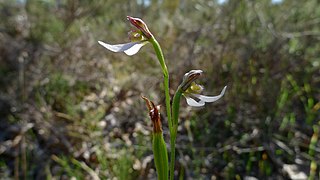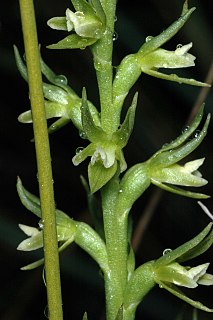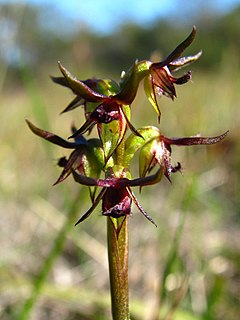
Eriochilus, commonly known as bunny orchids, is a genus of flowering plants in the orchid family, Orchidaceae that is endemic to Australia. Orchids in this genus are distinguished from those in the similar Caladenia by having a glabrous leaf and a densely woolly labellum. Species occur in south-west Western Australia, South Australia, Queensland, New South Wales, the Australian Capital Territory, Victoria, and Tasmania. Their common name alludes to their prominent ear-like lateral sepals.

Burnettia cuneata, commonly known as the lizard orchid, is the only species of the flowering plant genus Burnettia in the orchid family, Orchidaceae. It is a leafless terrestrial, mycotrophic herb with one or two leaf-like bracts and up to seven flowers that are brownish on the back and pink or white inside. It is endemic to southeastern Australia where it grows in dense thickets in swamps.

Caladenia gracilis, commonly known as musky caps or musky caladenia, is a plant in the orchid family Orchidaceae and is endemic to eastern and south-eastern Australia, including Tasmania. It is a ground orchid with a single leaf and up to six flowers which are dark-coloured on the back and white on the front, sometimes tinged with pink and with a strong musky or soapy odour. The species is also known as Caladenia moschata in Victoria.

Caladenia clarkiae, commonly known as pink caps, is a plant in the orchid family Orchidaceae and is endemic to south-eastern Australia. It is a ground orchid which grows singly or in small groups in Victoria and New South Wales. It has a single leaf and usually one or two white to pale pink flowers with darker pink tips.
Caladenia quadrifaria, commonly known as the large pink fingers orchid is a plant in the orchid family Orchidaceae and is endemic to New South Wales. It is a ground orchid with a single, sparsely hairy leaf and up to three pale to bright pink flowers.

Eriochilus cucullatus, commonly known as parson's bands, or leafless parson's bands, is a plant in the orchid family Orchidaceae and is endemic to Australia. It is a common and widespread, slender ground orchid with a single leaf and up to five small white to pale pink flowers. It grows in all Australian states except Western Australia and the Northern Territory.

Pterostylis pedunculata, commonly known as the upright maroonhood, is a species of orchid endemic to south-eastern Australia. Flowering plants have a rosette of two to six stalked leaves and a single green flower which is white near its base and tinged with reddish brown to black and with a gap between the petals and lateral sepals. It is common and widespread in a range of habitats.

Pterostylis falcata, commonly known as the sickle greenhood, is a species of orchid endemic to south-eastern Australia. It has a rosette of bright green leaves at the base of the plant and a single green and white, sickle-shaped flower. It is widespread and often common in Victoria but also occurs further north and west, and in Tasmania

Prasophyllum sylvestre, commonly known as the forest leek orchid, is a species of orchid endemic to south-eastern Australia. It has a single tubular, bright green leaf and up to thirty faintly scented, pale green, pink and reddish-brown flowers. It is similar to P. fuscum and P. affine but differs from them, including in the habitat in which they grow.

Prasophyllum lindleyanum, commonly known as the green leek orchid, is a species of orchid endemic to south-eastern Australia. It has a single smooth, tube-shaped leaf and up to twenty scented, greenish flowers with a greenish or white labellum with a pink tinge.
Prasophyllum candidum, commonly known as the Kiandra leek orchid, is a species of orchid endemic to eastern Australia. It has a single tubular, yellowish-green leaf and up to forty scented, bright white to greenish flowers. It grows in subalpine areas at altitudes above 1,000 m (3,000 ft) in New South Wales and Victoria although in the latter state it is considered to be a form of P. odoratum.
Prasophyllum parviflorum, commonly known as the slender leek orchid, is a species of orchid endemic to eastern Victoria. It has a single tubular leaf and up to thirty greenish-brown to purplish flowers. Further studies of the species may indicate that some collections currently included may be of a different species.
Prasophyllum nitidum, commonly known as the shining leek orchid, is a species of orchid endemic to southern continental Australia. It has a single tube-shaped leaf and up to twenty maroon, magenta or purple and green flowers with a pale purple to maroon labellum. It is a recently described plant, previously included with P. fitzgeraldii, but distinguished from that species by its shorter flower spike, glossy flowers and shining, raised labellum callus. It grows in the south-east of South Australia and in a single location in western Victoria.

Genoplesium archeri, commonly known as the elfin midge orchid and as Corunastylis archeri in Australia, is a small terrestrial orchid endemic to south-eastern Australia. It has a single thin leaf fused to the flowering stem and up to fifteen small, hairy, yellowish green flowers with purple stripes. It grows in a wide range of habitats in New South Wales, Victoria and Tasmania.

Genoplesium arrectum, commonly known as the erect midge orchid and as Corunastylis arrecta in Australia, is a small terrestrial orchid endemic to south-eastern Australia. It has a single thin leaf fused to the flowering stem and up to twenty small, dark purple flowers. It grows in a montane and subalpine grassland and forest in Victoria and the Australian Capital Territory.
Eriochilus petricola is a plant in the orchid family Orchidaceae and is endemic to New South Wales. It is a slender ground orchid with a single leaf and up to three small, white to pale pink flowers and grows near rock ledges.
Eriochilus pulchellus, commonly known as the granite bunny orchid, is a plant in the orchid family Orchidaceae and is endemic to Western Australia. It has a single egg-shaped leaf and up to ten small white flowers with red markings. A relatively common species, it grows in shallow soil on granite outcrops. Its fleshy leaf is held above the ground on a thin stalk.

Eriochilus scaber is a plant in the orchid family Orchidaceae and is endemic to Western Australia. It has a single leaf and up to three small red, pink and white flowers. Two subspecies are recognised based on the shape of the leaf and its height above the ground.
Eriochilus tenuis, commonly known as the slender bunny orchid, is a plant in the orchid family Orchidaceae and is endemic to Western Australia. It has a single egg-shaped leaf lying flat on the ground and one or two small pink or pink and white flowers. A common species, it grows in dense, shrubby forest and in winter-wet swamps.
Eriochilus valens, commonly known as the red-lipped bunny orchid, is a plant in the orchid family Orchidaceae and is endemic to Western Australia. It has a single egg-shaped leaf held above the ground and up to four small pink or white and pink flowers. It grows near winter-west swamps and usually only flowers after fire the previous summer.













